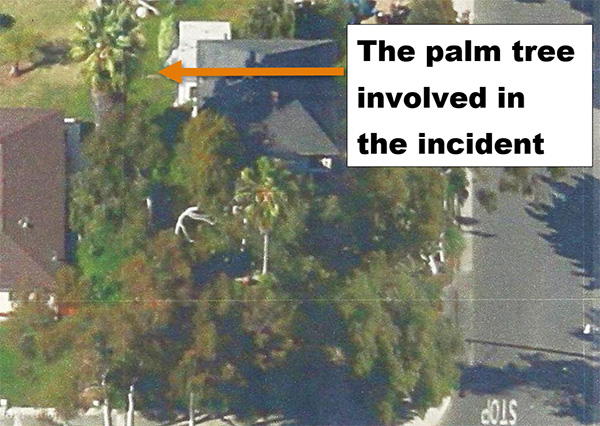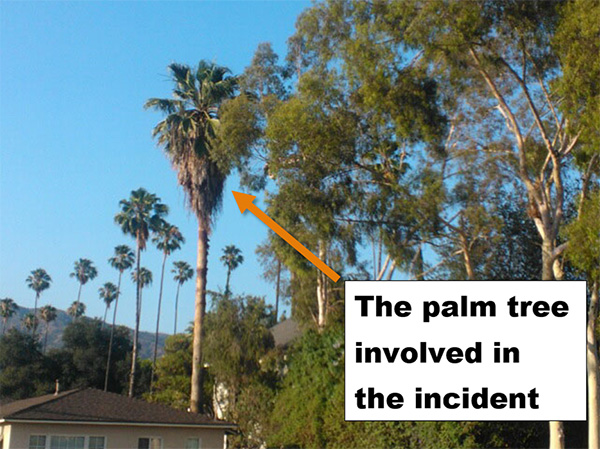Case Report: 12CA006
Tree trimmer dies when he is crushed by palm tree fronds
Download a PDF to print this report:
Tree trimmer dies when he is crushed by palm tree fronds (12CA006, PDF)
Summary
A tree trimmer died while trimming the palm fronds from a 50-foot palm tree in the yard of a private residence. This was the fourth palm tree the victim climbed that day. The victim climbed the palm tree and got underneath the dead palm fronds and began to pull them off the tree. A few minutes later the victim called for help, stating he was stuck and was suffocating. The police and fire departments responded to the coworker's 911 call, but were unable to reach the victim, so additional support was requested. Thermal imaging was used to locate the victim in the tree, and an aerial ladder truck was used to reach the victim. The victim was not trained or certified by any arborist or tree association. The contributing factors identified in this investigation were improper work practices in the removal of dead palm fronds and the lack of correct equipment. The CA/FACE investigator determined that, in order to prevent future incidents, tree care companies and self-employed tree workers who trim or remove palm trees should ensure that:
- Palm tree trimming or removal is performed or supervised by workers trained and certified by organizations such as the Tree Care Industry Association (TCIA) or the International Society of Arboriculture (ISA).
- Proper work procedures and equipment are used.
In addition, homeowners who need palm trees trimmed or removed should:
- Hire only tree workers who are trained or certified by organizations such as the TCIA or ISA. In addition, it is preferable that homeowners should only hire companies that have a current tree trimming contractor's license (in states where this is applicable).
Also, fire departments in locations with palm trees should:
- Develop and implement rescue protocols for trapped palm tree trimmers.
Introduction
On Saturday June 9, 2012, at approximately 5:00 p.m., a 35-year-old Hispanic male tree trimmer was asphyxiated when he was crushed by palm fronds he was trimming from a palm tree. The CA/FACE investigator received notification of this incident on June 14, 2012, by the Office of the Bureau of Investigations of the Division of Occupational Safety and Health (Cal/OSHA). On June 26, 2012, the CA/FACE investigator went to the incident site, interviewed the homeowner, and took pictures of the tree involved in the incident. On July 1, 2012, the victim's co-workers were interviewed.
Employer
The tree care service company hired by the homeowner to trim the palm trees in his yard had been in business for four years. The company did not have a current contractor's license in California. The homeowner had used this company many times in the past to maintain his trees. The company had three employees and performed tree trimming, pruning, removal, and other landscaping services.
Written Safety Programs and Training
The tree service company did not have a written injury or illness prevention program (IIPP) nor any formal training in palm tree trimming. The owner of the company stated that he had been trimming trees for over 20 years and learned through on-the-job training from other tree trimmers. The victim had also received on-the-job training.
Worker Information
The victim was a Hispanic male tree trimmer who was hired by the tree service company. The owner of the tree service company stated that he had known the victim for seven years and worked with him when they were both employees of another company. Whenever the owner of the tree service company had a big job he would call the victim to assist, and the victim would do the same whenever he had a large contract. In this case, the victim was not considered by Cal/OSHA to be an employee of the tree service company.
Incident Scene
The incident scene was a private residence on a street corner that had numerous palm trees and brush (Exhibits 1 & 2).
Weather
The weather on the day of the incident was clear with a mild southwesterly wind and a temperature of 78 to 82 degrees.
Investigation
On the day of the incident, the victim was assigned to trim the palm trees at the private residence. The owner of the tree service company was unable to climb anymore because of his age, and his son did not have the experience or equipment. The victim had experience and climbing gear. His climbing gear consisted of a rope attached to a climbing harness around his waist, a lanyard to go around the tree, and climbing gaffs that attached to his boots. After trimming three palm trees, the victim took a twenty-minute break before climbing the fourth and final tree. He placed a ladder against the tree and climbed up the ladder, then tethered himself to the tree and continued climbing slowly to the dead palm fronds approximately 40 feet up. When he reached the dead palm fronds, he climbed under the hanging fronds and started to pull them off with his hands. Some fell to the ground while others were suspended by the remaining uncut fronds. As he continued to pull off the fronds above him, the remaining fronds started to collapse around and onto him, pressing him against the tree trunk. Unable to move or free himself, and having difficulty breathing, he called for help. One of the co-workers below heard the victim yell for help. He looked up but could not see the victim, and called 911. He yelled up to the victim many times to assure him that help was on the way.
The fire department and paramedics received the call at 4:46 p.m. and arrived at the location within four minutes. They evaluated the situation and realized they needed more help to rescue the victim. An additional ladder truck and Urban Search and Rescue Task Force (Search and Rescue) were requested. The fire department personnel used thermal imaging to locate the victim in the tree and began the rescue operation. At 5:31 p.m., they reached the victim in the tree but he was unresponsive. Search and Rescue removed the victim from the tree and he was pronounced dead at the scene at 5:50 p.m.
Contributing Factors
Occupational injuries and fatalities are often the result of one or more contributing factors or key events in a larger sequence of events that ultimately result in an injury or fatality. The CA/FACE investigator identified improper work practices (such as removing multiple years of growth from below) and the lack of correct equipment as contributing factors in this incident that ultimately led to this fatality.
Cause of Death
The cause of death according to the death certificate was mechanical asphyxia.
Recommendations
The CA/FACE investigator determined that, in order to prevent future incidents, tree care companies and self-employed tree workers who trim or remove palm trees should ensure that:
Recommendation #1: Palm tree trimming or removal is performed or supervised by workers trained and certified by organizations such as the Tree Care Industry Association (TCIA) or the International Society of Arboriculture (ISA).
Discussion: In this incident, the victim had over 12 years of experience in tree trimming and may have been familiar with general safety procedures. However, it is not clear if this experience included knowledge of the best methods for trimming palm trees, or if the victim's skills had been rigorously assessed through job supervision and testing. The TCIA and ISA are two organizations that certify tree trimmers in all aspects of job safety, including the best methods for trimming palm trees. All TCIA and ISA-certified tree workers must attend formal trainings and pass a knowledge and skills exam conducted by trained evaluators. If the victim had received certification or was supervised by someone who was certified, he or the supervisor may have had the knowledge to recognize the hazards posed by the palm tree fronds and performed the job in a safe manner.
Recommendation #2: Proper work procedures and equipment are used.
Discussion: Safe methods for trimming palm trees include using a bucket truck or aerial device equipped with fall protection. When the use of a bucket truck/aerial device is not practical because of the tree location, workers may use a newly developed climbing procedure created by arborists in the San Diego and Los Angeles area that suspends the tree worker from the top of a palm tree, eliminating the need for working under the skirt. This procedure, which should only be used by a trained and experienced tree worker, involves:
- Using ropes, tools, and equipment designed for arborist work, and assuring this equipment is serviceable.
- Installing a throw line through the top of the palm tree needing trimming.
- Attaching an approved anchor line and pulley (block) to the throw line.
- Threading an approved climbing line through the block and hauling the block into the canopy, above the skirt of dead fronds. The climbing line must be long enough that when the block is raised, both ends of the climbing line will reach the ground.
- Securing the anchor line away from the base of the tree.
- Tying a friction hitch to the climbing line before ascending the tree, so that the worker is secured against falling at all times while aloft.
- Having one or two ground workers available, properly trained and equipped to assist the climber if needed.
Had the victim used these safe methods, this fatality might have been prevented.
Recommendation #3: Homeowners who need palm trees trimmed or removed should hire only tree workers who are certified by organizations such as TCIA or ISA. In addition, it is preferable that homeowners should only hire companies that have a current tree trimming contractor's license (in states where this is applicable).
Discussion: In this incident, the homeowner hired a tree care company that didn't have certified tree workers. A certified tree worker is an individual who has met specific qualifications and has demonstrated an acceptable level of skill and proficiency. When hiring a certified tree worker, homeowners are more likely to be dealing with a company with a standard of professionalism that protects consumers by:
- Having policies that promote the health, safety, and general welfare of the public.
- Ensuring that tree trimming is performed in a safe, competent, and professional manner.
- Adhering to the laws, regulations, and standards governing tree trimming.
- Providing resolution to disputes that arise from tree trimming activities.
- Educating consumers so that they make informed choices.
Had the homeowner hired a tree worker that was certified, this incident might have been prevented.
In addition, homeowners should hire tree care companies that have a current contractor's license. Under certain circumstances, homeowners may be liable for worker injuries or deaths that occur on their property if they hire unlicensed tree workers.
Recommendation #4: Fire departments in locations with palm trees should develop and implement rescue plans for trapped palm tree trimmers.
Discussion: In this incident, the initial call to 911 was transferred to a fire department dispatcher who was able to immediately dispatch the correct equipment and personnel required to deal with a palm tree rescue. The incident command unit arrived at the incident scene within four minutes from the 911 call, the first ladder truck arrived ten minutes after being dispatched, and the search and rescue task force arrived 38 minutes after being dispatched. The search and rescue task force was equipped with the specialized climbing rigging necessary for technical rescues. Once the search and rescue task force arrived, only nine minutes elapsed before the victim was first reached. The 28 minutes between the arrival of the ladder truck and the search and rescue task force were consumed by locating the victim within the drooping palm fronds, deciding the best ladder approach to the victim, and maneuvering the ladder truck into place given the difficult placement of the tree so far from the street and between two houses. In this incident, the firefighters initially responding to the incident had not received formal training in initial response to a palm tree rescue. A regular duty firefighter would not routinely be trained on the risk of palm frond suffocation or the most expeditious approach to reach and rescue the trapped victim. Fire departments that have a need to perform palm tree rescues should develop and implement a standard rescue protocol. This protocol should address:
- Written scripts for the initial dispatch.
- The proper mix of equipment and personnel, including at least two ladder trucks.
- The necessity of having pumpers on standby to wet the tree in case a tree worker's chainsaw or an electrical line has set the fronds on fire.
- Training every firefighter in the usual cause of death by suffocation from palm frond weight and the urgency of quick response.
- Training every firefighter in the choices for approaching the rescue (platform/ladder/lines) and how to set up the equipment for the rescue.
- Training all firefighters in the initial actions to be taken when the victim is first reached.
- The specialized technical training that the urban search and rescue task force will require to perform the actual rescue.
Additional scrutiny needs to be given to the issue of aerial platform equipment availability. The firefighters in this case were able to reach, treat, and rescue the victim using two ladder trucks. In most palm rescues, and in many other types of technical rescues, the added stability of an actual aerial platform rather than just ladder trucks can provide additional measures of speed and safety. Public emergency response agencies should consider the benefits of strategic purchase and placement of aerial platform trucks in large metropolitan areas. Although the response by the fire department in this incident was exemplary, it is possible that implementation of a more extensive palm tree rescue program with additional training of the first responders to the scene may have decreased the time needed to reach the victim and may have increased the chances that he would have survived.
Exhibits

Exhibit 1. An aerial view of the private residence where the incident occurred.

Exhibit 2. A street view of the palm tree involved in the incident.

Exhibit 3. A view of the palm tree from the neighbor's driveway.

Exhibit 4. A close up of the palm tree involved in the incident.
References
Division of Occupational Safety and Health -Title 8 regulations -Subchapter 7
General Industry Safety Orders Group 3. Tree Work, Maintenance or Removal §3421. General.
§3427. Safe Work Procedures. §3428. Operating Rules.
NIOSH Nationwide Alert on Dangers of Tree Trimming
Pruning Palms Safely (PDF) - Tree Care Industry Magazine article
Team-Based Palm Tree Rescue - Fire Rescue Magazine article
Authors
Hank Cierpich, FACE Investigator
Robert Harrison, MD, MPH, FACE Project Officer
Laura Styles, MPH, Research Scientist
November 12, 2013